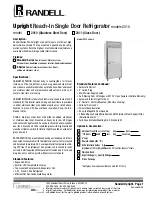
15
USING YOUR REFRIGERATOR
ADJUSTING CONTROL SETTINGS
Give the refrigerator time to cool down completely before
adding food. It is best to wait 24 hours before adding
food to the refrigerator. The mid-settings indicated in the
previous section should be correct for normal household
refrigerator usage. The controls are set correctly when
milk or juice is cold to your liking and ice cream is firm.
The refrigerator control functions as the thermostat for
the entire appliance. The higher the number setting, the
longer the compressor will run to keep the temperature
colder. The freezer control adjusts the cold air flow from
the freezer to the refrigerator. Setting the freezer control
to a lower temperature keeps more cold air in the freezer
compartment to make it colder.
If you need to adjust the temperature in the refrigerator
or freezer, begin by adjusting the refrigerator first. Wait
24 hours after the refrigerator adjustment to check the
freezer temperature. If it is too warm or too cold, then
adjust the freezer control as well.
Use the settings listed in the table below as a guide.
CONDITION/REASON:
RECOMMENDED
ADJUSTMENT:
REFRIGERATOR section
is too warm
• Opening the door often
• Adding a large amount
of food
• Room temperature is
very warm
Adjust the
REFRIGERATOR setting
to the next highest
number and wait 24
hours, then check.
FREEZER section is too
warm/ ice is made too
slowly
• Opening the door often
• Adding a large amount
of food
• Room temperature is
very low (not cycling
often enough)
• Using ice frequently
• Air vents blocked by
objects
Adjust the FREEZER
setting to the next
highest number and wait
24 hours, then check.
Remove any objects
blocking air flow.
REFRIGERATOR section
is too cold
• Controls not set
correctly for your
conditions
Adjust the
REFRIGERATOR setting
to the next lowest
number and wait 24
hours, then check.
FREEZER section is too
cold
• Controls not set
correctly for your
conditions
Adjust the FREEZER
setting to the next lowest
number and wait 24
hours, then check.
FOOD STORAGE GUIDE
ITEMS
HOW TO STORE
Storing Fresh Food
Wrap or store food in the
refrigerator in airtight and
moisture-proof material unless
otherwise noted. This prevents
food odor and taste transfer
throughout the refrigerator. For
dated products, check date code
to ensure freshness.
Butter or
margarine
Store opened butter in a covered
dish or in a closed compartment.
When storing a larger quantity,
wrap in freezer packing and
freeze.
Cheese
Store in original packaging until
you are ready to use it. Once
opened, tightly rewrap with
plastic wrap or aluminum foil.
Vegetables with
skins (carrots,
peppers)
Place in bags or plastic containers
inside the crisper.
Fruit
Wash and let dry; store in plastic
bags in the refrigerator. Do not
wash or pit berries until you
are ready to eat them. Berries
should be selected and kept in
their original packaging (if there
is any) or in a paper bag closed
halfway and set on a shelf.
Leafy Vegetables
Remove original packaging and
trim any dirty or discolored parts.
Wash in cold water and drain.
Place in a plastic bag or plastic
container and store in the crisper.
Fish
Consume fish or seafood the
same day purchased.
Chef Fresh
Store any meat in original airtight,
moisture-proof packaging
Rewrap if necessary.
Leftovers
Cover leftovers with plastic
wrap or aluminum foil. Plastic
containers with airtight lids can
also be used.
STORING FROZEN FOOD
NOTE:
For more information on how to prepare food to
be frozen such in a way to see the period they can be
stored consult a frozen food guide or cook book.
Packaging
A great freezing depends on how great you package the
food. When you seal the package make sure you remove
all excess air and do not allow humidity. A package that
is incorrectly sealed will result in the transmission of bad
odors, contaminants inside your refrigerator and will
cause your foods to dry.
MFL67241801_1.indd 15
6/9/2011 12:32:06 PM
















































